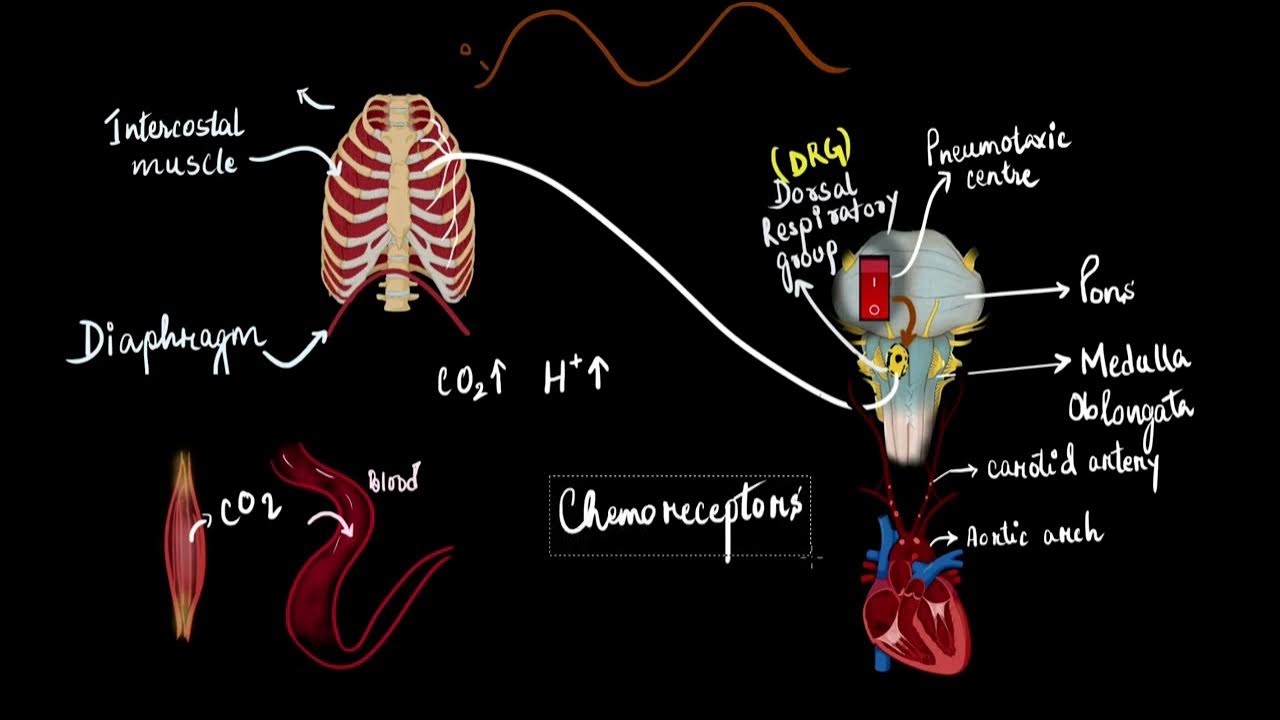Control of Ventilation, Animation
Summary
TLDRBreathing is an involuntary process that regulates the body’s oxygen and carbon dioxide levels, primarily controlled by the brainstem. Various centers in the medulla and pons adjust the rhythm and depth of breathing based on factors like carbon dioxide levels, pH, and oxygen. Chemoreceptors in the body monitor these changes and trigger the appropriate responses, while mechanoreceptors in the lungs help regulate airflow. Emotional states and pain can also affect breathing patterns. Though mostly automatic, breathing can be voluntarily controlled to some extent, such as during activities like singing or holding one's breath.
Takeaways
- 😀 Breathing is an involuntary process controlled by the body's need for oxygen and removal of carbon dioxide.
- 😀 The rate and depth of breathing are regulated by the body's metabolic state and carbon dioxide levels.
- 😀 The respiratory center in the brainstem processes information from receptors and adjusts the firing of neurons to regulate breathing.
- 😀 Inspiratory neurons control inhalation, while expiratory neurons regulate deep exhalation, since quiet expiration is passive.
- 😀 Motor neurons transmit signals to respiratory muscles, adjusting contraction to modify the rate and depth of breathing.
- 😀 Phrenic nerves control the diaphragm, while intercostal nerves control intercostal muscles, both essential for proper breathing.
- 😀 The brainstem's medulla contains critical centers such as the dorsal respiratory group (inspiration) and ventral respiratory group (expiration).
- 😀 The pre-Bötzinger complex in the brainstem acts as a rhythm generator, similar to a pacemaker in the heart.
- 😀 Breathing rate is primarily regulated by carbon dioxide concentration, which affects blood pH detected by chemoreceptors.
- 😀 Central chemoreceptors in the medulla monitor pH changes in cerebrospinal fluid, while peripheral chemoreceptors detect changes in blood pH, carbon dioxide, and oxygen.
- 😀 Mechanoreceptors in the lungs, including pulmonary stretch receptors, help manage the mechanical status of the lungs, affecting inspiration and expiration.
- 😀 Emotional states and pain can influence breathing through the limbic system and hypothalamus, potentially leading to gasping, crying, or hyperventilation.
- 😀 Voluntary control over breathing is possible, though limited, through conscious activities like singing, playing wind instruments, or holding breath underwater.
Q & A
What is the primary function of breathing?
-The primary function of breathing is to supply the body with oxygen and remove carbon dioxide.
How is the rate and depth of breathing regulated?
-The rate and depth of breathing are primarily regulated by the carbon dioxide status or the need for oxygen in the body.
What happens to breathing rate during physical exercise?
-During physical exercise, breathing rate automatically accelerates to meet the body's increased need for oxygen.
What role do respiratory receptors play in regulating breathing?
-Various receptors in the body provide information about its metabolic state to the respiratory center in the brainstem, which adjusts the breathing rate and depth accordingly.
What is the function of inspiratory and expiratory neurons?
-Inspiratory neurons fire during inspiration, while expiratory neurons only fire during deep expiration, since quiet expiration is a passive process.
Which nerves are most important for controlling breathing?
-The phrenic nerves, which control the diaphragm, and the intercostal nerves, which innervate the intercostal muscles, are the most important for controlling breathing.
What are the key centers involved in the regulation of breathing?
-The primary respiratory centers are located in the medulla, including the dorsal respiratory group (DRG), ventral respiratory group (VRG), and the pre-Bötzinger complex, with fine-tuning control provided by the pneumotaxic and apneustic centers in the pons.
How does carbon dioxide influence breathing rate?
-An increase in carbon dioxide lowers blood pH, which is detected by chemoreceptors, leading to faster, deeper breathing to expel the excess carbon dioxide and restore normal pH levels.
What is the role of mechanoreceptors in regulating breathing?
-Mechanoreceptors, such as pulmonary stretch receptors in the lungs, provide feedback about the mechanical status of the lungs, triggering reflexes to adjust breathing patterns, such as stopping inspiration when the lungs are overly inflated.
Can emotional states influence breathing patterns?
-Yes, the limbic system and hypothalamus can affect breathing, with emotions like pain, anxiety, or strong emotions leading to changes such as gasping, crying, or hyperventilation.
Outlines

Dieser Bereich ist nur für Premium-Benutzer verfügbar. Bitte führen Sie ein Upgrade durch, um auf diesen Abschnitt zuzugreifen.
Upgrade durchführenMindmap

Dieser Bereich ist nur für Premium-Benutzer verfügbar. Bitte führen Sie ein Upgrade durch, um auf diesen Abschnitt zuzugreifen.
Upgrade durchführenKeywords

Dieser Bereich ist nur für Premium-Benutzer verfügbar. Bitte führen Sie ein Upgrade durch, um auf diesen Abschnitt zuzugreifen.
Upgrade durchführenHighlights

Dieser Bereich ist nur für Premium-Benutzer verfügbar. Bitte führen Sie ein Upgrade durch, um auf diesen Abschnitt zuzugreifen.
Upgrade durchführenTranscripts

Dieser Bereich ist nur für Premium-Benutzer verfügbar. Bitte führen Sie ein Upgrade durch, um auf diesen Abschnitt zuzugreifen.
Upgrade durchführenWeitere ähnliche Videos ansehen

The regulation of respiration | Breathing and exchange of gases | Biology | Khan Academy

The REAL Reason You're Out of Breath Running (Not What You Think!)

How The Oxygen You Breathe Gets Delivered to the Cells of Your Body

A living fruit: Picked and still breathing

How Red Blood Cell Carry Oxygen and Carbon Dioxide, Animation

Structure and Function of LUNGS
5.0 / 5 (0 votes)
